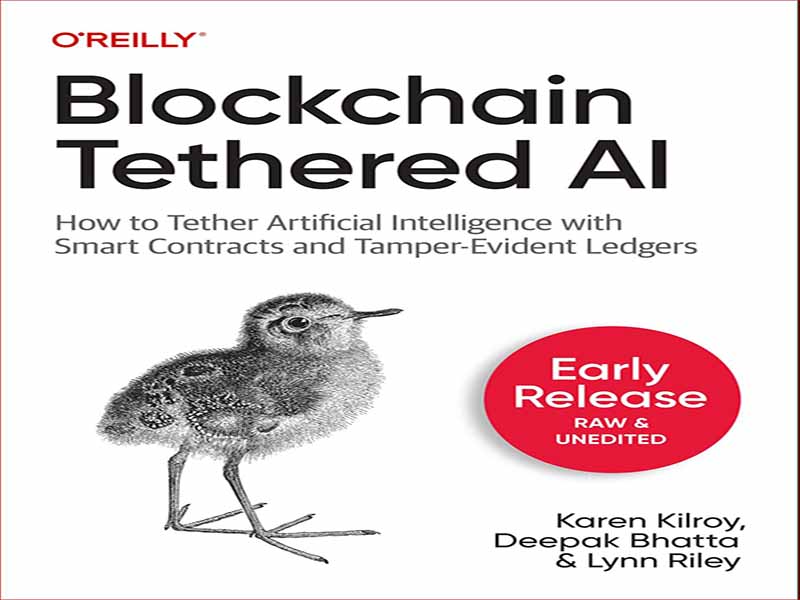- عنوان کتاب: Blockchain Tethered AI
- نویسنده: Rajesh Dhuddu
- حوزه: بلاکچین
- سال انتشار: 2023
- تعداد صفحه: 242
- زبان اصلی: انگلیسی
- نوع فایل: pdf
- حجم فایل: 30.6 مگابایت
این کتاب برای معماران نرم افزار و توسعه دهندگانی است که می خواهند هوش مصنوعی بنویسند که بتوان آن را تحت کنترل داشت. فرض بر این است که خواننده قبلاً درک درستی از سیستمهای هوش مصنوعی داشته و از نگرانیهای ناشی از انتشار این سیستمها آگاه است. همچنین فرض بر این است که خواننده تا حدودی با بلاک چین و نحوه عملکرد آن آشنا است. برای تکمیل تمرینها، خواننده باید ابتدا با NodeJS، Hyperledger Fabric و TensorFlow، PyTorch یا کتابخانههای معروف هوش مصنوعی دیگر آشنا شود و بتواند یک محیط توسعه مناسب برای اجرای تمرینها راهاندازی کند. به عنوان یکی از اعضای جامعه مهندسی نرم افزار، ممکن است قبلاً معتقد باشید که مزایای بالقوه هوش مصنوعی بسیار زیاد است، اما اگر مراقب نباشیم، هوش مصنوعی می تواند بشریت را نابود کند. این کتاب توضیح میدهد که چگونه میتوانید با افزودن استراتژیک تترهای بلاک چین، هوش مصنوعی مؤثر و غیر تهدیدکننده بسازید. تتر بلاک چین مانند یک گزارش است که رویدادهای تعیین شده را در آن ثبت می کنیم که بعداً می توان به آنها اشاره کرد. عیبیابی سنتی معمولاً به این معنی است که شما یک گزارش را بررسی میکنید، مشکلی را که رخ داده است را مشخص میکنید، گزارشهای دیگر را برای اطلاع از زمان و دلیل شروع مشکل بررسی میکنید و بعداً گزارشها را برای اطمینان از رفع مشکل بررسی میکنید. این روش با هوش مصنوعی پیچیدهتر میشود، زیرا دادهها و مدلها از مبداهای مختلفی تهیه میشوند و برخی از هوش مصنوعی میتوانند از طریق یادگیری ماشینی و ترکیب برنامهها تغییراتی را در خود ایجاد کنند. با استفاده از بلاک چین برای اتصال هوش مصنوعی – یعنی محدود کردن آن –، میتوانیم محدودیتهایی تعیین کنیم و مسیرهای حسابرسی برای هوش مصنوعی ایجاد کنیم که به ذینفعان و مصرفکنندگان کمک میکند تا بهتر به آن اعتماد کنند، و در صورت بروز مشکلات، به مهندسان کمک کنیم تا بفهمند چه اتفاقی افتاده و آن را اصلاح کنند. بازگشت.
This book is intended for software architects and developers who want to write AI that can be kept under control. It assumes that the reader already has an understanding of AI systems and is aware of the concerns that arise from the release of these systems. It is also assumed that the reader is somewhat familiar with blockchain and how it works. In order to complete the exercises, the reader should first become familiar with NodeJS, Hyperledger Fabric, and TensorFlow, PyTorch, or another popular AI library, and be able to set up an appropriate development environment in which to perform the exercises. As a member of the software engineering community, you may already believe that the potential benefits of AI are vast, but that if we aren’t careful, AI could destroy humanity. This book explains how you can build effective, non-threatening AI by strategically adding blockchain tethers. A blockchain tether is like a log, in that we record designated events in it that can later be referenced. Traditional troubleshooting usually means you peruse a log, pinpoint a problem that occurred, cross-check other logs to learn when and why the issue started, and later monitor the logs to be sure the issue is fixed. This method becomes more complex with AI, since the data and models are sourced from various origins, and some AI can make changes to itself through machine learning and program synthesis. By using blockchain to tether AI – that is, restrain it –, we can set restrictions and create audit trails for AI that help stakeholders and consumers to better trust it, and when problems arise, to help engineers to figure out what happened and wind it back.
این کتاب را میتوانید از لینک زیر بصورت رایگان دانلود کنید:
Download: Blockchain Tethered AI



































نظرات کاربران